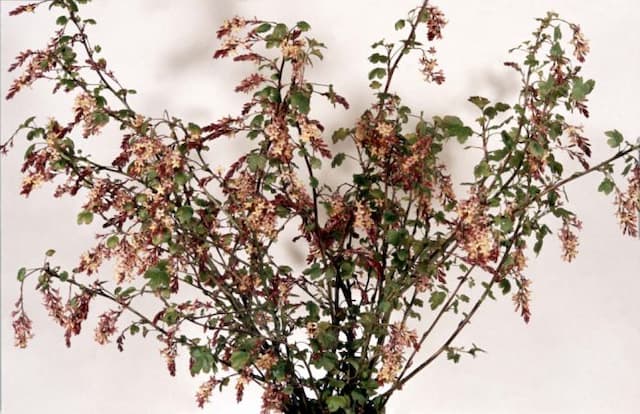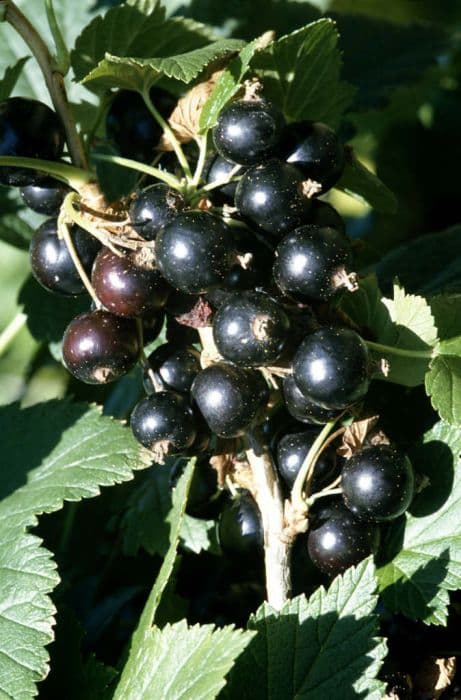White currant Ribes rubrum 'White Grape' (W)

ABOUT
The White currant, known as 'White Grape', is a cultivated variety displaying clusters of translucent, pale-yellow to white berries. Unlike its red counterpart, the white berries often have a sweeter, more delicate flavor. Each berry is small and spherical, like a tiny bead, often with a glossy finish that catches the light. The skin of the berries is smooth and thin, surrounding a juicy pulp within which small seeds are embedded. The plant itself is characterized by multiple upright stems that branch into a bushy form. Leaves are simple, with a softly lobed outline which provides a backdrop of lush greenery through the growing season. Flowers are generally inconspicuous, with tiny greenish-yellow petals that develop into the signature berries. The White currant 'White Grape' adds a bright and soft touch to gardens, often prized for both its ornamental and culinary uses, with the translucent fruit hanging in clusters that can resemble strands of white pearls amidst the green foliage. The contrast between the pale fruit and the dark branches can be quite striking, especially when the berries are ripe for picking.
About this plant
 Names
NamesSynonyms
White Grape Red Currant, White Currant
Common names
Ribes sativum, Ribes silvestre, Ribes niveum, Ribes vulgare, Ribes petraeum, Ribes prostratum.
 Toxicity
ToxicityTo humans
White currant is generally considered non-toxic to humans when ripe and can be eaten without harm. There are no commonly reported symptoms of poisoning from consuming ripe white currants as they are edible fruits.
To pets
White currant is not known to be toxic to pets. It is generally safe for animals if they consume the ripe fruit. However, always practice caution and consult a veterinarian if there are any concerns or if a pet consumes large quantities of any non-typical food.
 Characteristics
CharacteristicsLife cycle
Perennials
Foliage type
Deciduous
Color of leaves
Green
Flower color
Greenish-yellow
Height
3-5 feet (0.9-1.5 meters)
Spread
3-5 feet (0.9-1.5 meters)
Plant type
Shrub
Hardiness zones
3-7
Native area
Europe
Benefits
 General Benefits
General Benefits- Edible Fruits: Ribes rubrum 'White Grape', commonly known as White Currant, yields small, sweet berries that can be eaten fresh or used in cooking and baking.
- Attracts Wildlife: The White Currant's flowers and fruits attract birds and beneficial insects to the garden, promoting biodiversity.
- Ornamental Value: With its attractive berries and foliage, the White Currant adds visual interest to a garden space throughout the growing season.
- Easy to Grow: This plant is known to be hardy and relatively low maintenance, which makes it accessible to gardeners of various skill levels.
- Jam and Jelly Production: The fruits are often used to make jams, jellies, and other preserves, offering home gardening enthusiasts a rewarding project.
- Provides Shade: When grown in groups or as hedges, White Currant plants can create shaded areas in the garden.
- Drought Tolerant: Once established, the White Currant is somewhat drought-resistant, making it suitable for areas with water restrictions.
- Adaptable: The White Currant can adapt to a variety of soil types, though it prefers well-drained, fertile soil.
- Seasonal Interest: The plant provides seasonal interest with its spring flowers, summer fruits, and autumn leaf color changes.
- Privacy Screen: When planted in rows, the White Currant can serve as a natural privacy screen or windbreak.
 Medical Properties
Medical Properties- Antioxidant activity: Red currant berries, which include the 'White Grape' variety, are known for their high antioxidant content, contributing to reducing oxidative stress in the body.
- Vitamin C source: Red currant berries are a significant source of vitamin C, which is important for the immune system and skin health.
- Anti-inflammatory properties: The fruit may possess anti-inflammatory properties that can help reduce inflammation and related conditions.
- Digestive health: Red currant berries may aid digestion due to their fiber content and the presence of organic acids.
 Air-purifying Qualities
Air-purifying QualitiesThis plant is not specifically known for air purifying qualities.
 Other Uses
Other Uses- The berries of White Currant can be used to make a natural dye for fabrics, yielding pale yellow to green tints depending on the mordant used.
- The pectin-rich fruit can serve as a natural thickening agent for jams, jellies, and desserts without the need for additional pectin.
- White Currants can be utilized in an educational context, demonstrating plant growth, fruit development, and basic gardening techniques to students and novice gardeners.
- They serve as an excellent option for creating wildlife-friendly gardens, as birds are attracted to the fruits and help with plant propagation through seed dispersal.
- The canes of the White Currant make suitable natural supports for other plants in the garden that might require staking.
- When dried and crushed, the leaves can be added to potpourri mixes to impart a subtle fragrance.
- White Currant branches can be woven into decorative wreaths and other craft items due to their flexible nature when fresh.
- They can be used in culinary classes or workshops to teach participants about the characteristics and culinary uses of less common berries.
- Can be a subject for botanical illustration or photography, documenting the different growth stages and providing visual content for educational materials.
- Fresh White Currant sprigs can be used as an attractive and edible garnish for drinks and desserts.
Interesting Facts
 Feng Shui
Feng ShuiThe White Currant is not used in Feng Shui practice.
 Zodiac Sign Compitability
Zodiac Sign CompitabilityThe White Currant is not used in astrology practice.
 Plant Symbolism
Plant Symbolism- Purity: The 'White Grape' variety of the Red Currant (Ribes rubrum) typically symbolizes purity due to its clear, white berries contrasting against green foliage.
- Innocence: Similar to purity, the white color of the berries is often associated with innocence and simplicity.
- Vitality: The Red Currant is a hardy plant that represents life and vitality, thriving in many conditions and bearing fruit that is high in nutrients.
- Provision: As a fruit-bearing plant, Red Currants symbolize abundance and the provision of needs, reminding us of nature's generosity with its edible gifts.
- Joy: The bright color and sweet taste of Red Currants can represent joy and the simple pleasures of life.
 Water
WaterThe White Currant should be watered regularly, aiming to keep the soil consistently moist but not waterlogged. During the growing season, it may need watering as often as once a week, especially in dry conditions. Provide about 1 to 1.5 gallons of water each time you water to ensure deep soil saturation. In the winter, reduce watering since the plant requires less moisture when it is dormant. It's essential not to let the soil dry out completely, even during this period.
 Light
LightThe White Currant thrives best in full sun to partial shade. It should be planted in a spot where it receives at least six hours of sunlight daily. If the plant is grown in a climate with very hot summers, it can benefit from light shade during the peak afternoon sun to protect it from excessive heat.
 Temperature
TemperatureWhite Currants prefer cooler temperatures and can survive winter temperatures down to 0 degrees Fahrenheit. The ideal growing temperature is between 50 and 75 degrees Fahrenheit. These plants can tolerate frost and are hardy in cooler climates, making them suitable for northern gardens.
 Pruning
PruningPruning White Currants is essential for maintaining plant health and encouraging fruit production. Prune the bushes in late winter or early spring before new growth begins. Remove any dead, diseased, or broken branches, and thin out crowded areas to improve air circulation. The best time for pruning is while the plant is dormant to minimize stress and prevent disease entry.
 Cleaning
CleaningAs needed
 Soil
SoilWhite currant prefers well-drained, fertile soil with a pH between 6.0 and 6.5. The best soil mix for white currant includes loam or sandy loam enriched with compost or well-rotted manure to improve nutrient content and structure. A balanced mix should also ensure proper drainage to prevent root rot.
 Repotting
RepottingWhite currants typically don't need frequent repotting as they are usually cultivated outdoors in the ground. However, if grown in containers, repotting every 2-3 years can be beneficial to renew the soil and provide space for growing roots.
 Humidity & Misting
Humidity & MistingWhite currants flourish in average outdoor humidity levels. They do not require any special humidity conditions, as their natural environment provides the necessary moisture through the seasons.
 Suitable locations
Suitable locationsIndoor
Grow white currants in bright light with cool temperatures.
Outdoor
Plant white currants in sun, shelter, with moist soil.
Hardiness zone
3-8 USDA
 Life cycle
Life cycleThe Ribes rubrum 'White Grape', commonly known as White Currant, begins its life cycle as a dormant bare-root plant or from hardwood cuttings taken from a mature shrub. After planting, it enters the establishment phase where the root system develops and new shoots emerge; this is when the plant undergoes vegetative growth. In spring, the white currant blooms, producing small greenish flowers which, upon successful pollination by insects, develop into pale yellow translucent berries that are often white when ripe, typically by early to mid-summer. Following fruiting, the plant enters a period of senescence where it redirects energy to root and shoot development for the following year. The white currant is a deciduous plant and will shed its leaves in the fall, entering a state of dormancy during the winter months. The cycle recommences in spring as temperatures rise and day length increases, signaling the plant to break dormancy and begin its growth cycle anew.
 Propogation
PropogationPropogation time
Spring-Early Summer
The Ribes rubrum 'White Grape', commonly known as the White Currant, is typically propagated in late winter to early spring, before the new growth begins. The most popular method of propagation for white currants is through hardwood cuttings. This involves taking a cutting of about 6 to 8 inches (15 to 20 centimeters) from a healthy, mature plant during its dormant period. The cutting should include at least two or three buds. The lower end of the cutting is then dipped in rooting hormone and planted in a pot or in the ground with well-draining soil, ensuring that at least two buds are above the soil surface. The soil should be kept moist but not waterlogged to promote root development. In time, the cutting will establish a root system and can be transplanted to its final location.








